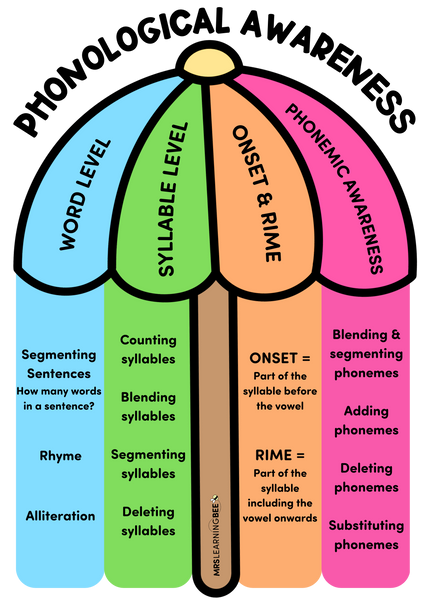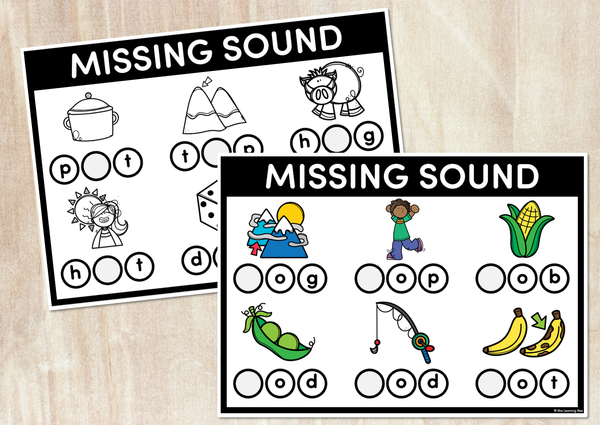Make reading exciting for your students with these fun phoneme segmentation activities for kindergarten! They are a fun way to support these essential literacy skills so you can set your students up for reading success.
Thanks to new research about how we really learn how to read, we now know that it's more important than ever to fully develop our students' phonemic awareness skills before we expect them to read the written word!
Students learn best when they start with something concrete and gradually move to the abstract. This new research about synthetic phonics tells us that our students’ reading abilities are directly linked to how well they can identify and manipulate the sounds in words.
This makes sense. Speaking is a physical act; all of us understand it intuitively. Reading, however, is an abstract skill that requires consistent and explicit instruction.
Our kindergarten kiddos need us to start with what they know - spoken language - so they can learn to read more efficiently and to ensure all our students are set up for literacy success.
What is phoneme segmentation?
Although it's easy to lump this skill in with the whole bubble of phonemic awareness skills, segmentation is about breaking a word into individual sounds. It's an intermediate phonemic awareness skill preceded by phoneme isolation and phoneme blending.

They all fit within the umbrella of phonological awareness skills. Learn more about these different terms in Phonics vs Phonemic Awareness.
Levels of Phonemic Awareness
- Phoneme isolation
- Phoneme blending
- Phoneme segmentation
- Phoneme addition
- Phoneme deletion
- Phoneme substitution
At this stage, your students should be able to hear a word and break it into sounds.
The word frog should become /f/ /r/ /o/ /g/. The word cat should become /c/ /a/ /t/.
This can be taught in many different ways, and it's an essential skill to practise throughout kindergarten.
How do you make phoneme segmentation fun & engaging for kindergarten students with a short attention span? I highly recommend getting hands-on! Use manipulatives and include a variety of physical movements, like drawing, playing, clapping, and more, to help make this learning as engaging as possible.
To them, it will feel like play, but they’ll be laying the foundation for their future phonics skills and reading abilities every single day!
7 Phoneme Segmentation Activities for Kindergarten
There are countless ways to practise identifying and segmenting phonemes! You can turn almost any material into a tool, depending on how you use it. You don't need to buy all of the tools right away, and you can often get by using materials you already have on hand!
Be creative and focus on the skill, not the stuff.
1. Listening to Sounds in Words
This is the easiest and most simplistic phonemic awareness activity. Your kids need only their ears (and maybe some fingers) to identify and segment the individual phonemes in different words.
It will take time for your kindergarten students to get used to this concept at the beginning of the school year, but if you keep modelling and practising, they'll get it!
Start by modelling this practice yourself. Break apart words verbally. Starting with your thumb, lift a finger for each phoneme you hear.
Examples
Dog: /d/ /o/ /g/
House: /h/ /ow/ /s/
Chin: /ch/ /i/ /n/
2. Sound Boxes
Also known as Elkonin boxes, sound boxes are a phenomenal way to support your students to identify the individual sounds in words. This practice supports orthographic mapping, which helps your students encode these spelling patterns to their long-term memory more efficiently than traditional memorisation.
These are best to use when your students have had a chance to isolate and blend sounds together, but you can also use them from day one of your instruction.
Essentially, students listen for the different sounds in a given word to get used to breaking them up. When they're ready to start writing, add the letter or groups of letters representing that sound in each box. For example, digraphs would go in one box since they represent one unique sound.
This visual approach really makes this abstract concept easier to understand. It's such an effective skill that I recommend using it with your whole group, small groups, or independent practice every single day. Any time you introduce a new word from your word list, run it through a sound box first!
You could also use these googly eyes to make it even more fun!
There are a bunch of great sound box activities and templates on my site to get you started:
3. Interactive Digital Slides
Since we have so many little things to track every single day, I highly recommend incorporating custom digital slides! I created them to be interactive to keep interest high, evidence-based to make them powerful and effective, and convenient so you won't have to worry about hunting down missing materials again.
I have a variety of slides to support different phonemic awareness skills, including:
- Phonological awareness slides: These are perfect for the beginning of the school year! Practise counting the words in sentences, identifying the beginning and ending sound in words, and more. In the 'count the sound' slides, the sound buttons are animated to flash as you say each sound.
- Heart words interactive slides: Instead of teaching sight words the old-fashioned way, teach them using the best evidence-based practices to help your students learn them faster than ever.
As part of The Hive, you'll also have access to my plethora of sound boxes and phonics activities!
The Hive is an intuitively designed and nimble digital teacher planner, but it’s also so much more. It includes literally hundreds of custom-built apps, downloads, printables, and more, so you can set up your entire day in just one program.
You'll be able to incorporate these phonemic awareness activities into your daily lessons and routines with no extra prep at all!
Join The Hive today and check it out!
4. Rhyming Games
One of the best ways to teach young children phoneme segmentation is by playing rhyming games! Kids love listening for rhyming words, and there are so many great rhyming books for kindergarten to reinforce this skill.
Most rhyming focuses on the vowel sound, which can be tricky to identify as they often sound similar.
Start by identifying word families (-all: ball, call, fall, etc) and then incorporate these rhyming words activities. Once they're ready, challenge them to listen for rhymes in longer passages, like with these poetry games.
5. Missing Sound Task Cards
One fun, accessible way to practice this skill is to incorporate picture cards with missing sounds. Students will need to say the name of the item on the card to identify the lost sound. Note- this is a more advanced way to practise segmenting, as it also incorporates phonics skills.
For example, if there is a picture of a pig and the letters __ig, students will need to think or say the word "pig" and then listen for the missing letter. This example is pretty simple, but they get more complex as they go!
You'll also find a range of missing sound activities in The Hive.
6. Segmenting Mats
It's so essential to practise phonemic awareness every day! These segmenting mats will help your students practise identifying, blending, and segmenting. Tuck them into reusable dry-erase pouches to be used again and again. Note- this is a more advanced way to practise segmenting, as it also incorporates phonics skills.
7. Segmenting Words with Manipulatives
This is where you bring out all the fun supplies and tools! There are so many ways to highlight the sounds in different words. You can use these materials to teach syllables, too!
Poppits
These fun fidget tools are perfect for segmenting phonemes! Just like sound boxes, students can click down for every sound they hear in a word.
These poppit task cards are the perfect way to incorporate these tools into your instruction!
Unifix Cubes
Unifix cubes are a great way to visually represent the number of phonemes in words while also sticking to a budget since most of us have some stashed in our supply cupboards anyway!
Pass out trays of unifix cubes and have your students lay out one for each sound they hear.
A great place to start with phoneme segmentation skills is CVC words. Since they only have three sounds, students quickly pick up the separate sounds and listen for them in words.
Learn how to teach CVC words the right way with these tips!
Magnetic Letters
Magnetic letters can be so helpful for so many different purposes! For phoneme segmentation, you can either write out a word for students to say and then segment, or you can say a word and use the letters to spell the sounds they identify in the word.
You can also offer these in your literacy centers for students to use independently.
Bingo Chips or Counters
As students read simple CVC words, have them place a bingo chip or counter on each phoneme they read. This is an easy activity to add to your independent practice time during literacy rotations!
Playdoh
Is there ever a time when playdoh isn't the answer? It’s especially great for kindergarten students who are also building their fine motor skills, I like to include tactile elements they need to use or manipulate in some way.
For this fun phonemic awareness activity, have them roll up small playdoh balls for each phoneme in a word. As they segment the word, they press a ball for each phoneme they hear.
Magnetic Flash Cards
Especially if you're teaching tricky words or heart words, these magnetic flashcards will make it easy to display your new words in your classroom.
As you say the word out loud, draw a dot underneath each phoneme. For heart words, draw a heart over any sections that don't follow conventional spelling.
These are also fantastic for identifying vowels and syllables!
Interactive Whiteboards
This is one of the easiest and most accessible tools you can use with your whole class or reading group! Have students record the phonemes they hear in words, draw sound boxes, or practice spelling words in their given spelling patterns.
They're affordable and easy to find, and I recommend every student have one in their desk.
Handheld Mirrors
One key part of phoneme awareness is teaching proper pronunciation and understanding how our mouths move as we speak. Especially early on, have your students watch how their mouths move as they say a word. Can they see how they're changing the shape of their mouths as they move from sound to sound?
This incredibly helpful practice can help students who don't quite understand phonemic awareness and need that tactile reminder.
Plus, this is a great thing to do in small groups to teach correct pronunciation and short vowel sounds!
Slinkies
Slinkies are another great tool for blending and segmenting activities.
More Phonemic Awareness Activities for Kindergarten
Once your students are confident in phoneme segmentation, it's time to increase the complexity!
Can your students add or remove a new sound into a word? Practice these higher-level skills with these phonemic deletion task cards.
Phonemic substitution is all about replacing the sound in any word with a different sound. Try these swap-the-sound games to help your students with this more complex skill.
Looking for more?
Make sure you're following along over on Instagram @mrslearningbee, where I share regular tips, tricks & lesson ideas for evidence-based literacy practices!
Happy segmenting!




















